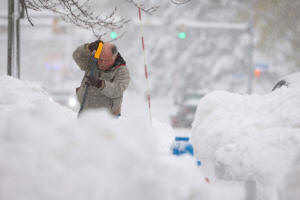Two deaths reported as 'lake-effect' snowstorm paralyzes western New
York
 Send a link to a friend
Send a link to a friend
 [November 19, 2022]
By Lindsay DeDario [November 19, 2022]
By Lindsay DeDario
BUFFALO, N.Y. (Reuters) -An early winter
"lake effect" storm dumped heavy snows on parts of western New York
state on Friday, with at least two deaths reported, travel disrupted and
icy powder expected to pile higher through the weekend.
The squalls blowing in from Lake Erie and Lake Ontario had dumped 3 to 5
feet (1-1.5 meters) or more of snow. Authorities said the deaths
appeared to be from heart attacks due to overexertion while clearing
snow in hard-hit Erie County.
As temperatures plunged, the region's first major snowstorm of the
season materialized on Thursday and intensified overnight into Friday,
well before the start of winter on Dec. 21.
Lake-effect squalls unleashed sporadic bursts of heavy precipitation
throughout the day, burying some areas in several feet of snow, and were
expected to persist through Sunday, according to the National Weather
Service.
By Friday evening, the weather service reported 5 1/2 feet (1.7 meters)
of snow measured in the Erie County village of Orchard Park, 15 miles
(25 km) south of Buffalo and more directly in the downwind of path of
frozen moisture blasting inland off Lake Erie.

Accumulations of 3 to 4 feet and more were recorded at several adjacent
locales by late afternoon, while Buffalo, the state's second-most
populous city with some 278,000 residents, awoke to nearly 14 inches (36
cm) Friday morning.
Erie County Executive Mark Poloncarz reported a partial building
collapse from the weight of fallen snow in the town of Hamburg, but no
further details were immediately available.
As the storm gained momentum, the weather service cited multiple
instances in which snow squalls were accompanied by claps of thunder and
flashes of lightning, a phenomenon called "thunder snow."
High winds and snow-draped tree limbs and power lines knocked out
electricity to thousands of customers, while the storm also forced
traffic closures along the New York Thruway and several other major
highways.
All but five of nearly 80 flights scheduled to depart from the Buffalo
Niagara International Airport on Friday were canceled, said the
facility's aviation director Lee Weitz.
'SNOW KING'
Even so, many western New Yorkers, accustomed to bouts of severe winter
weather seemed unfazed.
A Twitter user going by the name of @BuffaloSnowKing posted a video of
himself standing outside late on Thursday evening as snow blanketed his
yard. "How can you not enjoy this weather?!" he tweeted.
[to top of second column]
|

A man shovels snow during a snowstorm as
extreme winter weather hits Buffalo, New York, U.S., November 18,
2022. REUTERS/Lindsay DeDario

As of early Friday, road-travel bans that had kept motorists off the
streets overnight remained in effect for much of the central part of
Erie County. Mandatory restrictions were lifted, at least
temporarily, in lieu of travel advisories in northern and southern
parts of the county, including Buffalo.
With snow coming down at the rate of 1 to 3 inches an hour, plow
crews struggled to keep roads clear, and the strain of snow removal
proved too much for some.
"Unfortunately, we must report the passing of two Erie County
residents associated with cardiac events related to exertion during
shoveling/snow blowing," Poloncarz tweeted.
Snowfalls of such proportions are not uncommon for western New York
in November, when the relatively warm waters of the Great Lakes can
mix with frigid air in the upper atmosphere dropping down from the
Arctic, according to the weather service.
Illustrating the highly localized nature of lake-effect snow,
accumulation levels varied widely across the region. Still, 11
counties remained under an emergency declaration issued on Thursday
by New York Governor Kathy Hochul.
Erie County closed its offices on Friday, though essential staffers
were to report to work. The Buffalo Public Schools district, the
state's second-largest serving 32,000 students, canceled all classes
and closed offices on Friday.
The prospect of up to 4-1/2 feet of powder on the ground by the
close of the weekend prompted the National Football League to move
the Buffalo Bills' Sunday home game against the Cleveland Browns to
Detroit.
The storm developed as temperatures for the region, andmuch of the
rest of the northern United States, plunged 10 to 20 degrees
Fahrenheit (5-10 degrees Celsius) below average for this time of
year, said Rich Otto, a Storm Prediction Center meteorologist in
College Park, Maryland.
(Reporting by Lindsay DeDario; writing by Tyler Clifford and Steve
Gorman; Editing by Jonathan Oatis, Richard Chang and William
Mallard)
[© 2022 Thomson Reuters. All rights
reserved.]
This material may not be published,
broadcast, rewritten or redistributed.
Thompson Reuters is solely responsible for this content.
 |